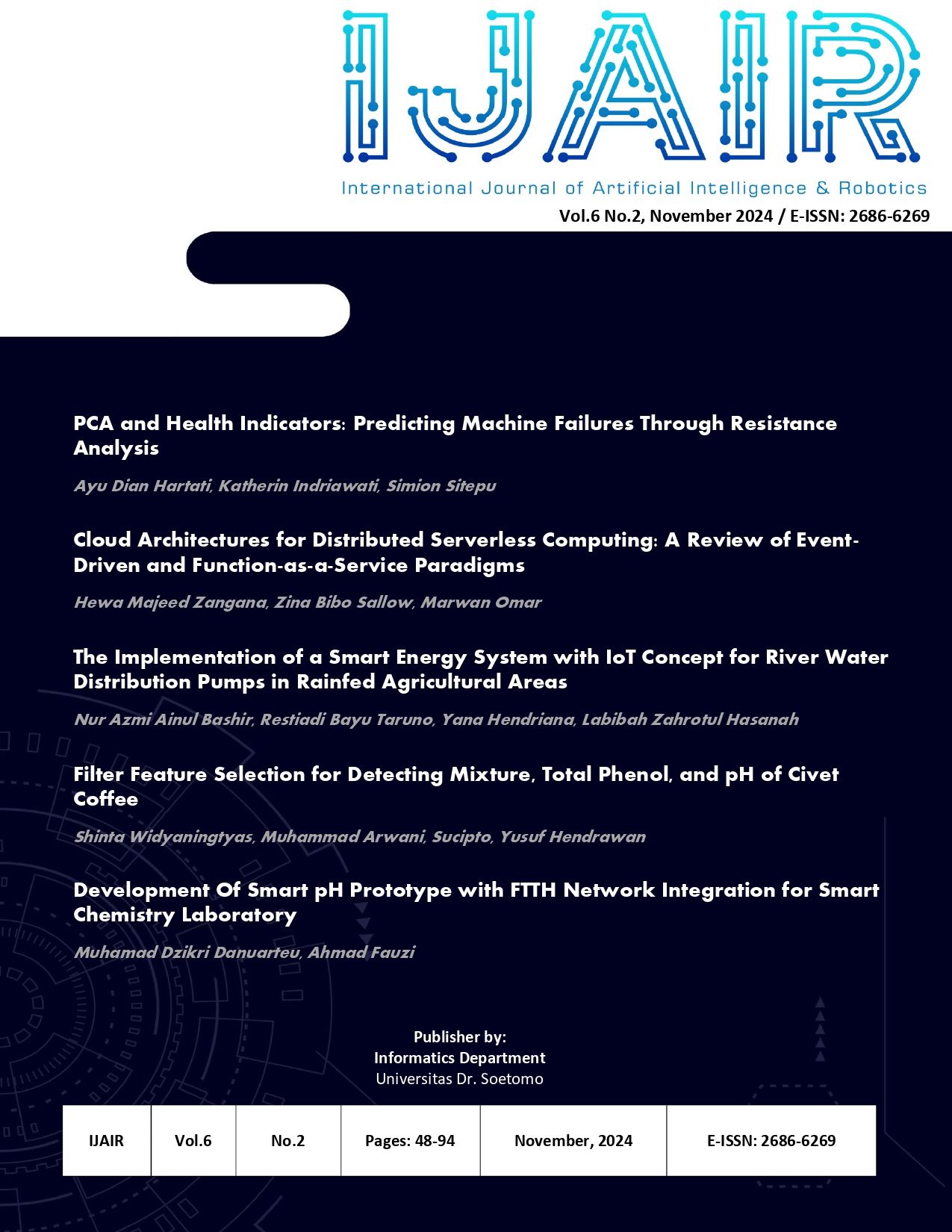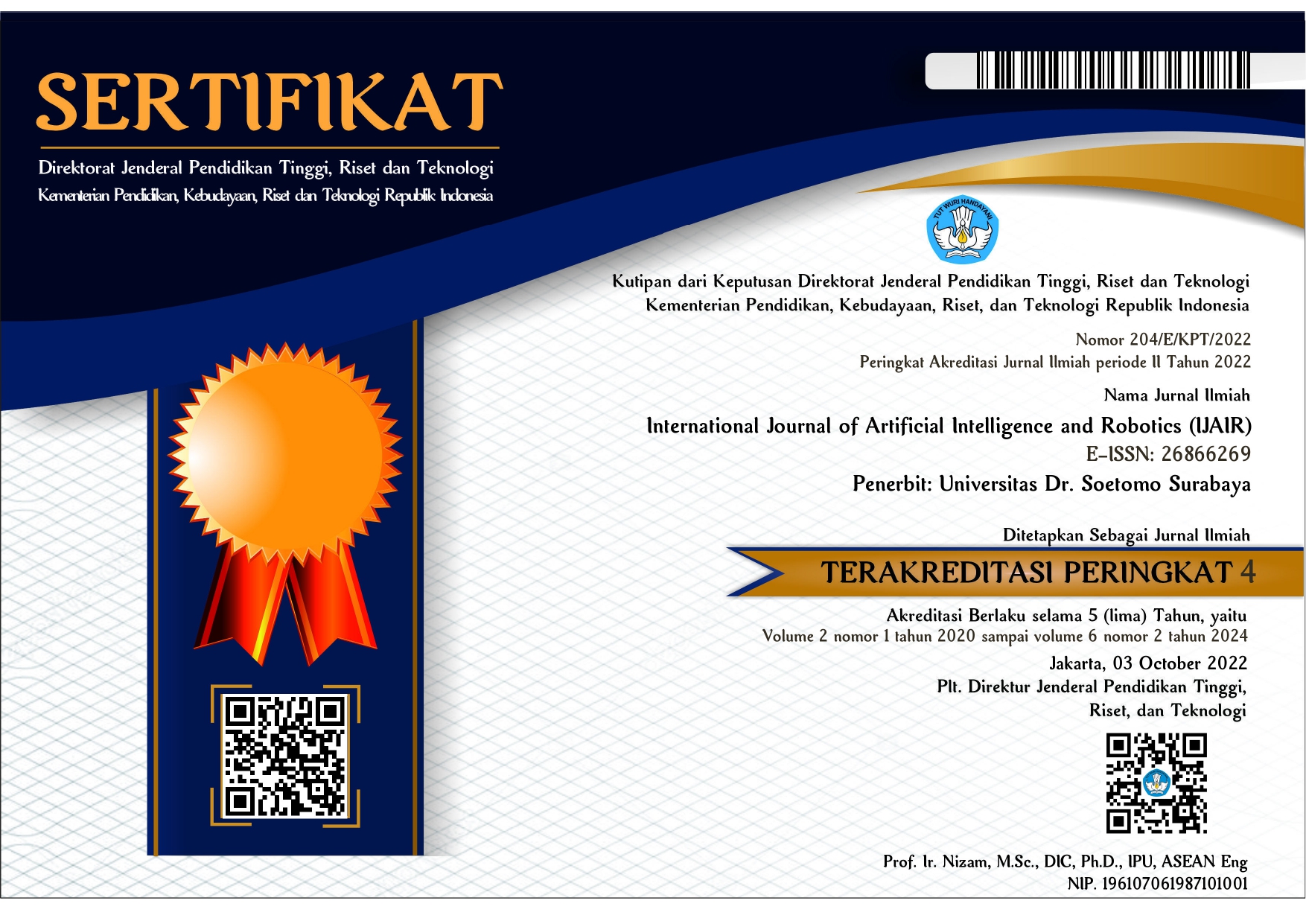PCA and Health Indicators: Predicting Machine Failures Through Resistance Analysis
 Abstract views: 183
,
Abstract views: 183
,
 PDF downloads: 135
PDF downloads: 135
Abstract
Predictive maintenance is crucial for ensuring industrial equipment's reliability and operational efficiency. This research aims to develop accurate health indicators to monitor real-time equipment conditions based on current signals. The methodology involves several key stages: collection of degradation data in current signals, data processing and mining, analysis using Principal Component Analysis (PCA), and development of health indicators. This study presents a comprehensive approach to converting raw degradation data into meaningful health indicators for effective engine prognostics and health management (PHM). Leveraging current signal data, we apply data mining and processing techniques to extract statistically significant features, including Standard Deviation, Peak to Peak, Root Mean Square (RMS), Crest Factor, Impulse Factor, Margin Factor, and Kurtosis. PCA is then used to reduce the dimensionality of the processed data, highlighting the principal components that capture the most significant variance indicating the machine's health. The resulting health indicators, derived from PCA, show a clear correlation between changes in additional load and increasing trends of PCA components and health indicators, thus validating the effectiveness of this approach in monitoring and predicting machine conditions. This methodology provides a robust real-time machine health assessment framework, facilitating timely maintenance and reducing the risk of unexpected failures. The results show that increasing resistance over time (t) leads to improved health indicators in a nonlinear manner, providing valuable insights for timely intervention before critical failure occurs. This analysis demonstrates a strong correlation between daily incremental resistance changes and machine condition as monitored by PCA and health indicators. Consistent upward trends in PCA scores and health indicators validate the effectiveness of this technique in tracking engine health under varying resistance conditions.
Downloads
References
R. Khelif, B. Chebel-Morello, S. Malinowski, E. Laajili, F. Fnaiech, and N. Zerhouni, "Direct Remaining Useful Life Estimation Based on Support Vector Regression," IEEE Trans. Ind. Electron., vol. 64, no. 3, pp. 2276–2285, 2017, doi: 10.1109/TIE.2016.2623260.
E. Zio, "Some Challenges and Opportunities in Reliability Engineering," IEEE Trans. Reliab., vol. 65, no. 4, pp. 1769–1782, 2016, doi: 10.1109/TR.2016.2591504.
T. Chen, T. Feng, Y. Yu, L. Guo, H. Gao, and W. Lfi, "Adaptive weighted fault growth parameters: New statistic parameter health indicators for machine performance degradation assessment," Measurement, vol. 216, p. 112830, 2023, doi: https://doi.org/10.1016/j.measurement.2023.112830.
J. Pan et al., "Probabilistic remaining useful life prediction without lifetime labels: A Bayesian deep learning and stochastic process fusion method," Reliab. Eng. Syst. Saf., p. 110313, 2024, doi: https://doi.org/10.1016/j.ress.2024.110313.
L. Guo, Y. Yu, A. Duan, H. Gao, and J. Zhang, "An unsupervised feature learning based health indicator construction method for performance assessment of machines," Mech. Syst. Signal Process., vol. 167, p. 108573, 2022, doi: https://doi.org/10.1016/j.ymssp.2021.108573.
Q. Ni, J. C. Ji, and K. Feng, "Data-Driven Prognostic Scheme for Bearings Based on a Novel Health Indicator and Gated Recurrent Unit Network," IEEE Trans. Ind. Informatics, vol. 19, no. 2, pp. 1301–1311, 2023, doi: 10.1109/TII.2022.3169465.
Y.-S. Zhao, P. Li, Y. Kang, and Y.-B. Zhao, "A health indicator enabling both first predicting time detection and remaining useful life prediction: Application to rotating machinery," Measurement, vol. 235, p. 114994, 2024, doi: https://doi.org/10.1016/j.measurement.2024.114994.
Y. Lei, N. Li, L. Guo, N. Li, T. Yan, and J. Lin, "Machinery health prognostics: A systematic review from data acquisition to RUL prediction," Mech. Syst. Signal Process., vol. 104, pp. 799–834, 2018, doi: https://doi.org/10.1016/j.ymssp.2017.11.016.
A. Aasi, R. Tabatabaei, E. Aasi, and S. M. Jafari, "Experimental investigation on time-domain features in the diagnosis of rolling element bearings by acoustic emission," J. Vib. Control, vol. 28, no. 19–20, pp. 2585–2595, 2022, doi: 10.1177/10775463211016130.
T. Yan, D. Wang, B. Hou, and Z. Peng, "Generic Framework for Integration of First Prediction Time Detection With Machine Degradation Modelling from Frequency Domain," IEEE Trans. Reliab., vol. 71, no. 4, pp. 1464–1476, 2022, doi: 10.1109/TR.2021.3087698.
Y. Duan, X. Cao, J. Zhao, and X. Xu, "Health indicator construction and status assessment of rotating machinery by spatio-temporal fusion of multi-domain mixed features," Measurement, vol. 205, p. 112170, 2022, doi: https://doi.org/10.1016/j.measurement.2022.112170.
Q. Ni, J. C. Ji, K. Feng, and B. Halkon, "A fault information-guided variational mode decomposition (FIVMD) method for rolling element bearings diagnosis," Mech. Syst. Signal Process., vol. 164, p. 108216, 2022, doi: https://doi.org/10.1016/j.ymssp.2021.108216.
J. Coble and J. Wesley Hines, "Identifying optimal prognostic parameters from data: A genetic algorithms approach," Annu. Conf. Progn. Heal. Manag. Soc. PHM 2009, pp. 1–11, 2009.
G. Zhang, Y. Wang, X. Li, Y. Qin, and B. Tang, "Health indicator based on signal probability distribution measures for machinery condition monitoring," Mech. Syst. Signal Process., vol. 198, p. 110460, 2023, doi: https://doi.org/10.1016/j.ymssp.2023.110460.
Z. Masoumi, B. Moaveni, S. M. Mousavi Gazafrudi, and J. Faiz, "Air-gap eccentricity fault detection, isolation, and estimation for synchronous generators based on eigenvalues analysis," ISA Trans., vol. 131, pp. 489–500, 2022, doi: https://doi.org/10.1016/j.isatra.2022.04.038.
N. Tandon and A. Choudhury, "A review of vibration and acoustic measurement methods for the detection of defects in rolling element bearings," Tribol. Int., vol. 32, no. 8, pp. 469–480, 1999, doi: https://doi.org/10.1016/S0301-679X(99)00077-8.
Y. Lei, J. Lin, Z. He, and M. J. Zuo, "A review on empirical mode decomposition in fault diagnosis of rotating machinery," Mech. Syst. Signal Process., vol. 35, no. 1, pp. 108–126, 2013, doi: https://doi.org/10.1016/j.ymssp.2012.09.015.
J. Ben Ali, N. Fnaiech, L. Saidi, B. Chebel-Morello, and F. Fnaiech, "Application of empirical mode decomposition and artificial neural network for automatic bearing fault diagnosis based on vibration signals," Appl. Acoust., vol. 89, pp. 16–27, 2015, doi: https://doi.org/10.1016/j.apacoust.2014.08.016.
J. Ben Ali, B. Chebel-Morello, L. Saidi, S. Malinowski, and F. Fnaiech, "Accurate bearing remaining useful life prediction based on Weibull distribution and artificial neural network," Mech. Syst. Signal Process., vol. 56–57, pp. 150–172, 2015, doi: https://doi.org/10.1016/j.ymssp.2014.10.014.
L. Saidi, J. Ben Ali, and F. Fnaiech, "Bi-spectrum based-EMD applied to the non-stationary vibration signals for bearing faults diagnosis," ISA Trans., vol. 53, no. 5, pp. 1650–1660, 2014, doi: https://doi.org/10.1016/j.isatra.2014.06.002.
R. T. Rato, M. D. Ortigueira, and A. G. Batista, "On the HHT, its problems, and some solutions," Mech. Syst. Signal Process., vol. 22, no. 6, pp. 1374–1394, 2008, doi: https://doi.org/10.1016/j.ymssp.2007.11.028.
G. Chen and Z. Wang, "A signal decomposition theorem with Hilbert transform and its application to narrowband time series with closely spaced frequency components," Mech. Syst. Signal Process., vol. 28, pp. 258–279, 2012, doi: https://doi.org/10.1016/j.ymssp.2011.02.002.
S. Li and J. Wen, "A model-based fault detection and diagnostic methodology based on PCA method and wavelet transform," Energy Build., vol. 68, pp. 63–71, 2014, doi: https://doi.org/10.1016/j.enbuild.2013.08.044.
A. Ajami and M. Daneshvar, "Data driven approach for fault detection and diagnosis of turbine in thermal power plant using Independent Component Analysis (ICA)," Int. J. Electr. Power Energy Syst., vol. 43, no. 1, pp. 728–735, 2012, doi: https://doi.org/10.1016/j.ijepes.2012.06.022.
R. Penha and J. W. Hines, "Using principal component analysis modeling to monitor temperature sensors in a nuclear research reactor," 2001.
N. B. Gallagher, B. M. Wise, S. W. Butler, D. D. White, and G. G. Barna, "Development and Benchmarking of Multivariate Statistical Process Control Tools for a Semiconductor Etch Process: Improving Robustness through Model Updating," IFAC Proc. Vol., vol. 30, no. 9, pp. 79–84, 1997, doi: https://doi.org/10.1016/S1474-6670(17)43143-0.
Copyright (c) 2024 Ayu Dian Hartati, Katherin Indriawati, Simion Sitepu

This work is licensed under a Creative Commons Attribution-ShareAlike 4.0 International License.
Authors who publish with International Journal of Artificial Intelligence & Robotics (IJAIR) agree to the following terms:
-
Authors retain copyright and grant the journal right of first publication with the work simultaneously licensed under a Creative Commons Attribution License (CC BY-SA 4.0) that allows others to share the work with an acknowledgment of the work's authorship and initial publication in this journal.
-
Authors are able to enter into separate, additional contractual arrangements for the non-exclusive distribution of the journal's published version of the work (e.g., post it to an institutional repository or publish it in a book), with an acknowledgment of its initial publication in this journal.
-
Authors are permitted and encouraged to post their work online (e.g., in institutional repositories or on their website) prior to and during the submission process, as it can lead to productive exchanges, as well as earlier and greater citation of published work.















